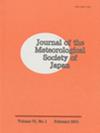对流层上层槽对2018年7月日本强降雨事件的影响
IF 1.6
4区 地球科学
Q3 METEOROLOGY & ATMOSPHERIC SCIENCES
引用次数: 23
摘要
在这项研究中,我们研究了2018年7月5日至8日给日本西部广大地区带来强降雨的降雨系统的特征,以及在该事件期间停留在大降雨区后方的对流层上层槽所起的作用。全球降水测量核心卫星上的双频降水雷达显示,10 km以下的降水贡献显著,层状降水覆盖的空间范围广,在大的层状降水区域内存在对流降水。这些特征是组织良好的降雨系统的特征。根据气象资料分析,与气候条件相比,与该事件有关的大尺度环境条件相对稳定,对流层大部分地区非常潮湿。这种大范围的环境,与之前极端降雨事件的统计结果一致,出现在日本的广大地区。我们发现,槽在维持有利于降雨组织的环境方面发挥了重要作用。与低压槽相关的动力上升在对流层中层和对流层上层产生垂直水汽通量辐合,并与水平水汽通量辐合一起使对流层大部分变湿。对流层中下层的潮湿条件在对流层下层对流不稳定时增强了深层对流的发展。一旦深层对流以这种方式得到促进,对流本身就可以通过非绝热上升进一步湿润对流层中高层,从而使自由对流层充满水分。这种动力效应和绝热效应之间的协同作用增强了条件,使得一个组织良好的降雨系统能够在日本的大部分地区产生非常强的降雨。本文章由计算机程序翻译,如有差异,请以英文原文为准。
The Effects of an Upper-Tropospheric Trough on the Heavy Rainfall Event in July 2018 over Japan
In this study, we examined the characteristics of a rainfall system that brought heavy rainfall to a broad portion of western Japan on July 5 – 8, 2018, and the role played by an upper-tropospheric trough which stayed at the rear of the extensive rainfall area during the event. The Dual-Frequency Precipitation Radar onboard the core satellite of the Global Precipitation Measurement revealed the significant contribution of rainfall with its top below 10 km, the broad spatial extent covered by stratiform rainfall, and the presence of convective rainfall embedded in the large stratiform rainfall area. These features are characteristic of well-organized rainfall systems. Based on the analysis of meteorological data, large-scale environmental conditions related to the event were found to be relatively stable and very humid throughout most of the troposphere compared with the climatology. This largescale environment, which is consistent with previous statistical results for extreme rainfall events, was present across an extensive area of Japan. We found that the trough played an important role in the maintenance of an environment favorable for rainfall organization. Dynamical ascent associated with the trough acted to produce vertical moisture flux convergence in the mid-troposphere and upper troposphere and moistened most of the troposphere in conjunction with horizontal moisture flux convergence. Humid conditions in the midto lower troposphere enhanced the development of deep convection when the lower troposphere was convectively unstable. Once deep convection was promoted in this way, convection itself could moisten the midto upper troposphere further through diabatic ascent, thereby loading the free troposphere with moisture. This synergy between the dynamical effect and the diabatic effect enhanced the conditions that allowed for a well-organized rainfall system that produced very heavy rainfall over a large portion of Japan.
求助全文
通过发布文献求助,成功后即可免费获取论文全文。
去求助
来源期刊
CiteScore
6.70
自引率
16.10%
发文量
56
审稿时长
3 months
期刊介绍:
JMSJ publishes Articles and Notes and Correspondence that report novel scientific discoveries or technical developments that advance understanding in meteorology and related sciences. The journal’s broad scope includes meteorological observations, modeling, data assimilation, analyses, global and regional climate research, satellite remote sensing, chemistry and transport, and dynamic meteorology including geophysical fluid dynamics. In particular, JMSJ welcomes papers related to Asian monsoons, climate and mesoscale models, and numerical weather forecasts. Insightful and well-structured original Review Articles that describe the advances and challenges in meteorology and related sciences are also welcome.

 求助内容:
求助内容: 应助结果提醒方式:
应助结果提醒方式:


